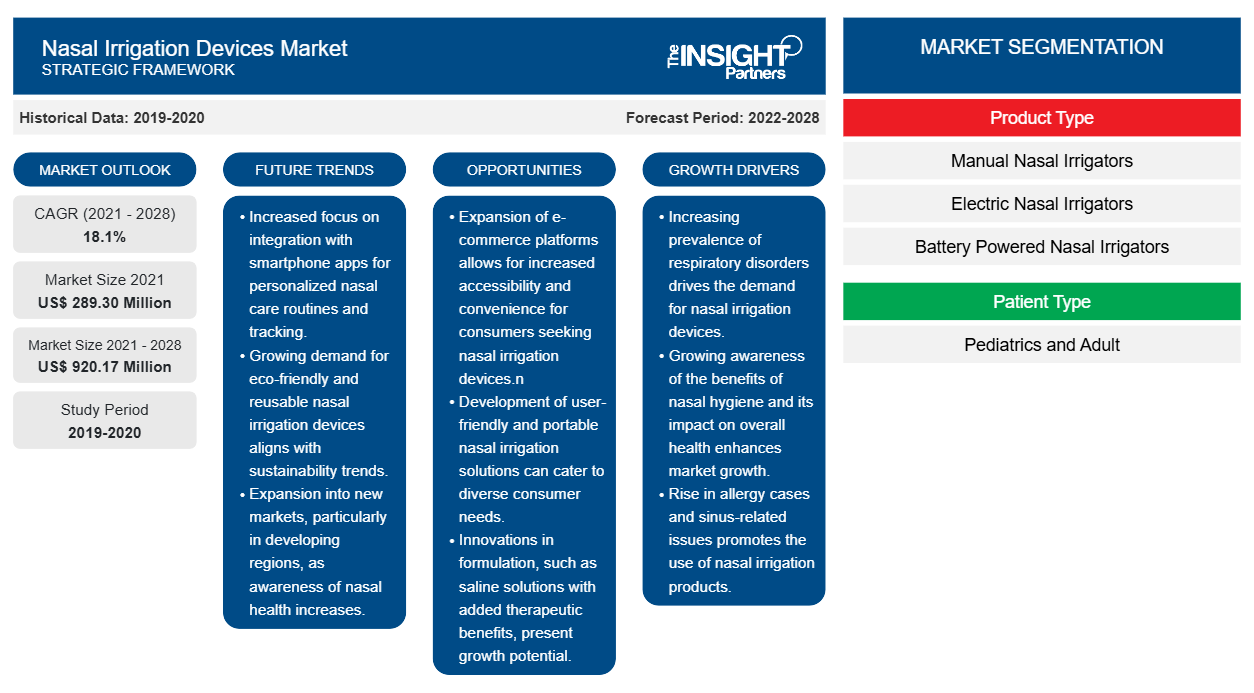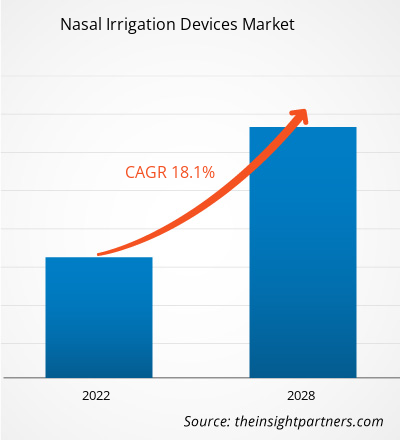The nasal irrigation devices market was valued US$ 289.30 million in 2021, it is estimated to grow at a CAGR of 18.1% from 2022 to 2028.
Nasal irrigation is a traditional practice of cleaning a nasal passage with the help of saline and distilled water using devices such as neti pot, squeeze bottle, and electric nasal irrigators. These devices have specially designed nozzles that aid efficient and effective cleaning of the nasal passage.
The nasal irrigation devices market is segmented into product type, patient type, application, end user, and geography. By geography, the market is broadly segmented into North America, Europe, Asia Pacific, the Middle East & Africa, and South & Central America. This report offers insights and in-depth analysis of the market, emphasizing parameters such as market trends and market dynamics. It also includes the competitive analysis of leading players in the nasal irrigation devices market.
Customize This Report To Suit Your Requirement
You will get customization on any report - free of charge - including parts of this report, or country-level analysis, Excel Data pack, as well as avail great offers and discounts for start-ups & universities
Nasal Irrigation Devices Market: Strategic Insights

-
Get Top Key Market Trends of this report.This FREE sample will include data analysis, ranging from market trends to estimates and forecasts.
Market Insights
Rise in Prevalence of Nasal Allergies & Infectious Diseases and Increasing Awareness About Benefits of Nasal Irrigation Drive Nasal Irrigation Devices Market Growth
Over the past few years, there has been significant growth in the cases of allergies and infectious diseases affecting the upper respiratory tract. There has been a significant surge in sinusitis, rhinitis, bronchiolitis, and other post-operative conditions, which require nasal irrigation for a speedy recovery; further inflammation and bacterial deposition may worsen the conditions. According to a report by the Sinus & Allergy Wellness Center, sinusitis affects 30 million adults annually in the US; ~11.6% of American adults were diagnosed with sinusitis in 2020. Therefore, the increasing prevalence of sinusitis has affected the activities of an individual, aiding the demand for nasal irrigation and driving the nasal irrigation devices market. A surge in the prevalence of upper respiratory tract infections amid rapid-paced industrialization and elevating pollution levels is also fueling the demand for nasal irrigation devices. With a rise in pollution, allergens and pollutants present in air may cause nasal passage blockage, and the excessive deposition of such chemicals or substances can further lead to sinusitis and other nasal problems. Nasal irrigation benefits by aiding allergen washout, pulling out fluid, improving breathing, clearing sinuses passage, etc. Of late, the awareness of these benefits has increased among consumers, translating into high demand for nasal irrigation devices.
Nasal irrigation, which is now adopted worldwide, has a long history dating back to Ayurveda. Nevertheless, nasal irrigation devices have evolved notably from squeeze bottles to neti pots. Battery-powered and electric nasal irrigation devices, which are gaining considerable popularity, allow a consistent flow of saline water into the nasal cavity. Developing economies in Asia Pacific, and South and Central America are focused on the development and use of such devices. PT Kalbe Farma Tbk launched the first electric nasal cleanser ever made in Indonesia under the brand name Elvasense Portable Nasal Washer. The continued development of novel devices for better results and an increase in the production of nasal irrigation devices in developing economies are expected to create lucrative opportunities for the growth of the market during the forecast period.
Product Type Insights
Based on the product type, the nasal irrigation devices market is segmented into manual nasal irrigators, electric nasal irrigators, and battery powered nasal irrigators. The manual nasal irrigators segment is further segmented into neti pot, squeeze bottle, and baby bulb syringe. The manual nasal irrigators segment held the largest market share in 2021. However, the battery powered nasal irrigators segment is anticipated to register the highest CAGR during the forecast period owing to the rising trend for portable healthcare products.
Patient Type Insights
Based on patient type, the nasal irrigation devices market is bifurcated into adult and pediatrics. In 2021, the adult segment held a larger market share. Moreover, the same segment is expected to grow at the fastest CAGR from 2022 to 2028. The market dominance of this segment is attributed to the enlarging demand for nasal irrigation devices to treat sinus infections, allergies, colds, and flu, especially among the growing geriatric populations worldwide.
Application Insights
Based on application, the nasal irrigation devices market is segmented into sinus, rhinitis, bronchiolitis, post-operative respiratory conditions, and others. In 2021, the sinus segment held the largest share of the market. Also, the same segment is expected to register the highest CAGR from 2022 to 2028. The market growth of this segment is ascribed to the increasing sinus conditions and initiatives taken by key players.
End User Insights
Based on end user, the nasal irrigation devices market is segmented into home care settings, hospitals and clinics, and others. In 2021, the home care settings segment holds the largest share of the market, and it is expected to register the fastest CAGR from 2022 to 2028.
Inorganic developments such as mergers and acquisitions, and expansion are highly adopted strategies by the global nasal irrigation devices market players. A few of the recent key market developments are listed below:
- In May 2022, Medtronic announced the acquisition of Intersect ENT, expanding the company's comprehensive ear, nose, and throat (ENT) portfolio with innovative products used in sinus procedures to improve postoperative outcomes and treat nasal polyps. Intersect ENT's product lines and customer base will further Medtronic's efforts to positively impact patients suffering from chronic rhinosinusitis (CRS).
- In November 2021, NeilMed Phamaceuticals Inc. announced a significant expansion of its Sonoma County production facilities as sales are expanding, particularly outside the United States.
- In October 2021, Air Liquide announced the acquisition of Betamed S.A., a major home healthcare provider in Poland, to develop its home healthcare business in Europe.
The regional trends and factors influencing the Nasal Irrigation Devices Market throughout the forecast period have been thoroughly explained by the analysts at The Insight Partners. This section also discusses Nasal Irrigation Devices Market segments and geography across North America, Europe, Asia Pacific, Middle East and Africa, and South and Central America.
Nasal Irrigation Devices Market Report Scope
| Report Attribute | Details |
|---|---|
| Market size in 2021 | US$ 289.30 Million |
| Market Size by 2028 | US$ 920.17 Million |
| Global CAGR (2021 - 2028) | 18.1% |
| Historical Data | 2019-2020 |
| Forecast period | 2022-2028 |
| Segments Covered |
By Product Type
|
| Regions and Countries Covered |
North America
|
| Market leaders and key company profiles |
|
Nasal Irrigation Devices Market Players Density: Understanding Its Impact on Business Dynamics
The Nasal Irrigation Devices Market is growing rapidly, driven by increasing end-user demand due to factors such as evolving consumer preferences, technological advancements, and greater awareness of the product's benefits. As demand rises, businesses are expanding their offerings, innovating to meet consumer needs, and capitalizing on emerging trends, which further fuels market growth.

- Get the Nasal Irrigation Devices Market top key players overview
Company Profiles
- Air Liquide Medical Systems
- NEILMED PHARMACEUTICALS INC
- Stryker Corporation
- SinuPulse
- Heal Force
- Bremed Ltd.
- RhinoSystems, Inc
- Flaem Nuova S.p.A.
- Medtronic Plc
- Bayer AG
Frequently Asked Questions
What is the regional market scenario of the nasal irrigation devices market?
Who are the key players in the nasal irrigation devices market?
Which end user segment held the largest market share in the nasal irrigation devices market?
Which application segment led the nasal irrigation devices market?
Which patient type segment held the largest market share in the nasal irrigation devices market?
What is meant by the nasal irrigation devices market?
What are the driving factors for the nasal irrigation devices market across the globe?
Which product type segment led the nasal irrigation devices market?
- Historical Analysis (2 Years), Base Year, Forecast (7 Years) with CAGR
- PEST and SWOT Analysis
- Market Size Value / Volume - Global, Regional, Country
- Industry and Competitive Landscape
- Excel Dataset
Recent Reports
Related Reports
Testimonials
Reason to Buy
- Informed Decision-Making
- Understanding Market Dynamics
- Competitive Analysis
- Identifying Emerging Markets
- Customer Insights
- Market Forecasts
- Risk Mitigation
- Boosting Operational Efficiency
- Strategic Planning
- Investment Justification
- Tracking Industry Innovations
- Aligning with Regulatory Trends





















 Get Free Sample For
Get Free Sample For